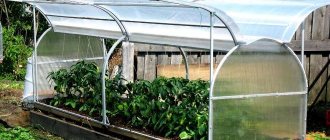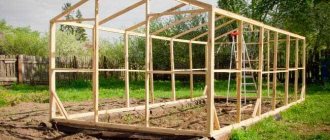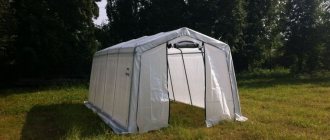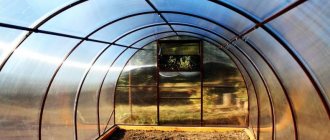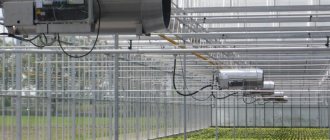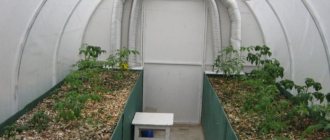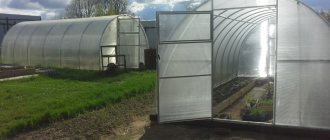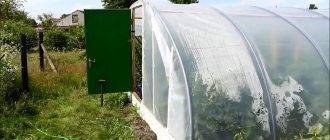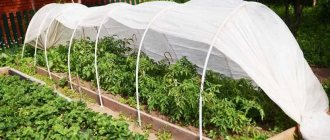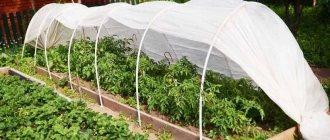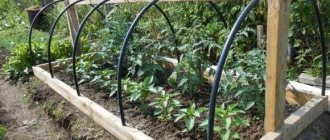SHARE ON SOCIAL NETWORKS
FacebookTwitterOkGoogle+PinterestVk
Greenhouses made of arcs with covering material are very popular because they have a simple design, are light in weight and are excellent for installation both in large greenhouses and in open ground. The length of such a greenhouse can be from 4 to 10 m, so choosing a suitable option is not difficult. In addition, in addition to purchasing a ready-made design, you can also consider the option of making it yourself.
Greenhouse made of arcs with covering material
Peculiarities
Covered greenhouses based on arcs have the following advantages:
- simplicity of design and self-production;
- light weight;
- ease of installation both in the greenhouse and in open ground;
- do not require foundation construction.
The design can have different dimensions, depending on the area of the site, the crops grown and personal preferences. Most often, greenhouses are used for growing seedlings, but they are also suitable for flowers and other low-growing plants.
This is a kind of mini-greenhouse that can be used from the beginning of March until almost the end of autumn. In the southern regions, planting is sometimes carried out even in February. Covering material protects plants from cold and scorching sun.
Advantages and disadvantages
Among the positive properties of arched greenhouses are:
- do not require special skills for installation;
- can be installed on a summer cottage without a foundation;
- are foldable, easy to carry from place to place;
- have a low cost.
We should also not forget about some of the disadvantages of arched greenhouses:
- the covering material requires replacement after a few years because it is not quite strong and durable;
- a greenhouse under the influence of strong, gusty winds can easily move from its original installation area.
Covering material
The greenhouse has an arched shape. It consists of arcs onto which covering material is stretched. There are 2 main types of covering materials:
- polyethylene film;
- non-woven fabric.
The structure can have different heights, depending on the type of crop, usually 0.5-1.5 m. For example, 0.5 m is enough for cucumbers and any seedlings; eggplants and tomatoes require a higher structure.
The length, as a rule, varies from 3 to 10 m. In the photo of arc greenhouses you can clearly see the types and features of such greenhouse structures.
Film
The most affordable option. You can use simple polyethylene film, which is popular due to its low cost. Air-bubble fabric is often used; it has a higher density and therefore lasts longer.
The film usually lasts for several seasons and provides reliable protection against frost. You can purchase the film at hardware and gardening stores. Often sold complete with arches.
Non-woven
There are quite a few types of such canvases, differing in density. The latter must be at least 42 g/m2 for effective protection against frost. The denser the fabric, the more resistant the structure is to precipitation and wind.
Non-woven fabrics are held more reliably on the arcs and retain heat well, but have a higher cost compared to polyethylene. For fixation, you can use ordinary clothespins or special clips.
It is better to use both film and non-woven material. At the beginning of the season, the mini-greenhouse is covered with film to warm the soil and accelerate the emergence of seedlings. After the seedlings reach the optimal height (depending on the type of crop), the film is removed and a non-woven fabric is stretched so that the plants can “breathe”.
Polycarbonate
Polycarbonate can be used as a covering material. Usually it is not used to make classic temporary greenhouses, but stationary greenhouses.
Mounted on a metal profile or wooden frame. It has high rigidity and density, retains heat well and transmits sunlight. But it requires a more reliable and stable frame.
Manufacturing of metal structures
Choosing a metal version of the frame, of course, will have to work hard, but it is stronger and more reliable. You will need a welding machine and the ability to use it. Due to the strength of the metal, bending a rod into an arc is not easy. More often they cut it in half in order to secure it by welding and bend it at the desired angle.
Greenhouse frame made of metal arcs
The algorithm of actions is as follows:
- Place the base of the frame: lay a corner or square around the perimeter, connecting it together by welding. If there is a foundation, pins or other fasteners are left in the latter, to which the base should be connected.
- There will be a long rod running along the top of the greenhouse in the middle (along). Initially, it can be strengthened using two vertical profiles located on two different sides.
- Weld pieces of corners or crosses into the places where the arcs are installed on the base. Make similar blanks on the top crossbar. Step – 50 cm. Make sure that they are evenly spaced.
- Weld each rod at the bottom to the workpiece. Bend it, attach it to the top crossbar.
- Using a similar principle, mount the rod on the second side.
- Construct all the arcs in the same way.
- On the pediment, install vertical posts from a profile or corner, which will become a frame for the door. Attach loops to them.
- Weld a door from the corner. Hang it on the hinges.
- If it is necessary to make vents, the principle of their installation coincides with the installation of the door.
Greenhouse made of metal arcs
Attention! The metal gets very hot from the sun and has an additional negative effect on polyethylene, reducing its service life. The heat insulator can be a light fabric wound around the arc. You will not encounter a similar problem if you choose the option of making arches made of plastic.
Selecting arcs
You can buy ready-made arcs for a greenhouse or make them yourself. Products made from various materials are on sale. It is better to choose products that are more flexible and malleable; they are easier to install. The most commonly used are plastic, aluminum and steel arches.
Aluminum
The most expensive and difficult to install. Made in the form of aluminum pipes. May vary in length depending on needs. It is important to use a thick-walled profile, otherwise it may burst. Aluminum products are non-corrosive, lightweight and durable.
Metal-plastic
Easy to cut and bend, relatively inexpensive. One of the most popular options. They can be used to make greenhouses of complex configurations. Lightweight, durable and strong, they can last for decades without deteriorating.
It is recommended to purchase pipes with a large diameter hole. Such products are more durable and less susceptible to corrosion.
Plastic
Plastic arcs for greenhouses are the most inexpensive. It is not necessary to use special products; many gardeners make their own arcs from plastic water pipes.
It is advisable to choose thick-walled, wire-reinforced pipes. The plastic bends and deforms well. If the wall thickness is too large, the product can be heated to facilitate bending. They benefit from affordable cost, durability and ease of installation.
Steel
Metal arcs for greenhouses are characterized by increased strength and long service life. Made from small diameter steel pipes. Provide high reliability.
But bending such material is much more difficult; special equipment may be required, for example, a pipe bender. Round and rectangular pipes can be used.
Metal in PVC
A practical and durable solution. The base of the product is made of rigid wire about 5 mm in circumference. The metal is coated with PVC to protect against corrosion and aggressive environments.
The products are easily deformed, which makes it possible to construct greenhouse structures of any complexity. The disadvantage is the relatively low stability, so a stronger mount is required to protect against wind.
Dimensions
A greenhouse can have almost any size. You need to focus on the landscape of the site, the characteristics and number of plants grown. The length of the greenhouse arc is usually at least 3-4 m, maybe more.
The longer the arcs, the higher and wider the finished structure can be. The width and height must be proportional, otherwise the greenhouse will turn out to be unstable. Typically, structures are built with a width of 1.2-1.5 m. The height in most cases does not exceed 1.5 m. If the plants are tall, the height can be 3 m, but this will be more likely a full-fledged greenhouse.
The width of the greenhouse should be approximately 30 cm wider than the bed itself. The number of arcs is selected based on the length of the bed. The optimal distance between the arcs is 1 m. The size of the covering material is calculated based on the length, height and width of the structure.
For example, if a greenhouse has a width and height of 1 m, and a length of 6 m, a film measuring 9.5 x 4.5 m will be required. There should always be a reserve for more reliable fixation.
Video description
This video contains all the basic information about the Dayas greenhouse
Greenhouse "Agronomist"
This greenhouse is also simple and similar in many respects to the previous model. The frame is also made of metal tubes coated with polyvinyl chloride. For installation, the kit also includes pegs, 20 cm long.
The agronomist greenhouse is very easy to install on any soil, thanks to its metal frame Source cs.aviarydecor.com
The height of the Agronomist is not much greater than the Dayasa. Most manufacturers make such arcs so that the entire structure is 0.9 meters from the ground. But you can adjust this parameter by manipulating the arches. The use of a sectional design allows you to adjust the length of the greenhouse. Standard kits include materials for building a 4 or 6 meter greenhouse, and they cost from 800 to 1000 rubles.
To create such a greenhouse, high-quality and durable Agrotex 42 fabric is used. It has proven itself well and has received recognition from gardeners throughout Russia. If you are going to lengthen the structure, then you can buy this kind of covering material for a greenhouse, the price of which is notable for its affordable price.
Independent construction
Most gardeners, in order to save money, prefer to make greenhouses themselves. Arches for a greenhouse for a garden bed can be made from leftover water pipes, metal rods, or even fairly thick hazel branches.
First, determine the width and height of the structure; the length of the arcs directly depends on this. Most often, greenhouses are made with a width of 1.2 m. This is enough for seedlings, herbs or cucumbers. The height is selected according to the growth characteristics of the plants.
The base is made of wooden beams in the form of a rectangular box. The height of the frame should not be more than 15 cm. The structure can be assembled directly on the site of the future bed.
You can make a frame from plastic pipes, but in this case additional compaction will be required to prevent deformation.
Next, the pipes are cut into pieces of the required length. It is best to use plastic pipes; they are durable and most amenable to processing. Holes should be made in the frame to secure the pipes.
The arcs are bent in such a way as to form an arched structure. If the greenhouse is long and high, additional stiffeners need to be installed along the entire length. These can be the same plastic pipes connecting all the arcs.
The covering material is stretched onto a completely finished frame. You need to pull it tightly enough so that it does not sag. But excessive tension should not be applied; this can lead to rupture of the material, which is especially true for ordinary polyethylene.
To secure the covering material, it is best to use special clamps, but you can also get by with ordinary plastic clothespins. It is important to attach the film not only to the arches, but also to the base of the structure. It is permissible to use several layers of film.
This greenhouse can be used from early spring until late autumn. It should be disassembled in the summer, otherwise the plants may die due to excessively high temperatures. In winter, the covering material must be removed, otherwise it may tear under the weight of the snow.
